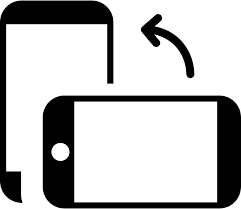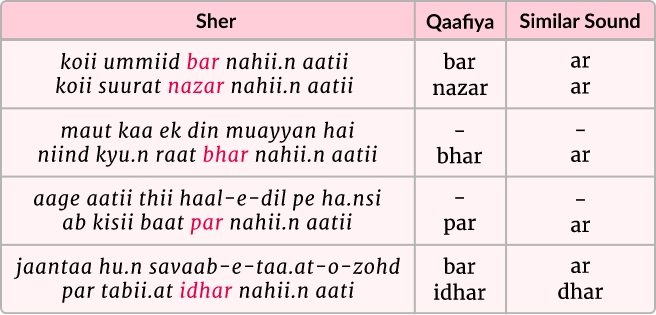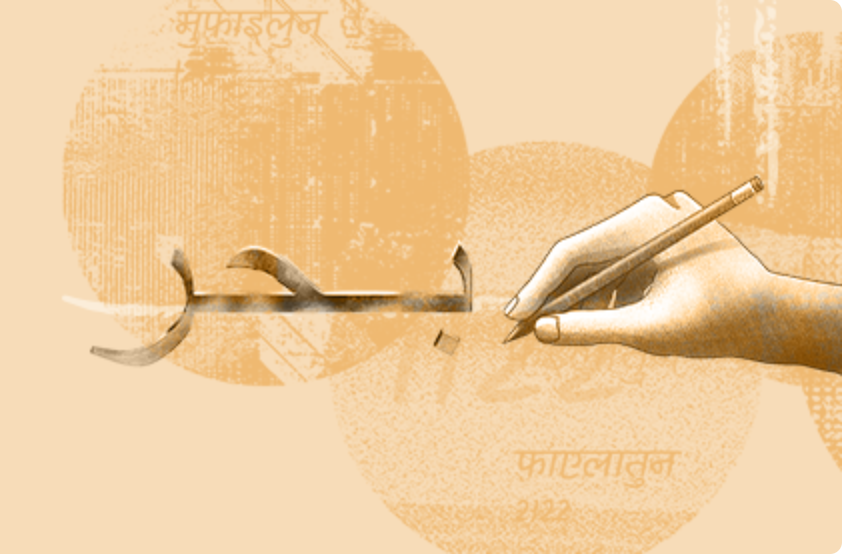
Qaafiya dictionary
Explore a vast library of over 10,000+ words derived from an extensive collection of 70,000 Ghazals that are available on Rekhta.
Learn how to use Qaafiya Dictionary
A step-by-step guide on how to use the Qaafiya Dictionary to find rhyming words.
Start learning
Introduction to Qaafiya
Qaafiyaa is an essential component in a Ghazal and creates its rhyming pattern. It is a set of words that has the same sound as another within a group.
For example: Aan, Baan, Shaan are Qaafiya with “aan” being the similar sound. The word Qaafiya is derived from Arabic word “qauf”, which means “that which follows”.
The rhyming structure in Urdu poetry is explained below:

In most ghazals, the matla, (i.e. first sher of the ghazal) has qaafiyaa in both lines (misras). Thereafter the qaafiyaa is essential in the second misra of each sher. In the above ghazal, the first sher is the matla and the qaafiyaa are highlighted : bar, nazar, bhar, par, idhar
Rekhta Qaafiya Dictionary is an online tool which enables one to find similar sounding qaafiyaas for the given word. This is primarily meant for aspiring poets and can also be a reference for established poets.
How to use Qaafiya Dictionary?
Rekhta Qaafiya Dictionary presents search results based on two components. Rhyming pattern (sound) of the word as well as the weight (vazn), which is critical to Urdu poetry
1. RHYMING PATTERN
Search results of similar rhyming words will be broadly divided into categories based on the rhyming pattern of the searched word.
- • EXACT
- • CLOSE
- • OPEN

2. WEIGHT (Vazn) of the Word
Results are segregated according to their weight. Check the weight of the word using Rekhta Taqti.
Guideline for Qaafiya Selection
Qaafiya of a word can be exact, nearby (close) or open. This categorization is clearly mentioned in the search results of Rekhta Qaafiya Dictionary.
The selection set of qaafiya for a Ghazal is linked with the first sher of the Ghazal, i.e. matla. The type of qaafiya (exact, close, open) used in the matla should be used in the rest of the shayari.
 Example of the Exact Qaafiya is given below...
Example of the Exact Qaafiya is given below...

This sher uses --yaa sounding qaafiyas. Hence, the rest of the Ghazal should use qaafiyaa pattern like above example...
 Example of the Close Qaafiya is given below...
Example of the Close Qaafiya is given below...

This sher uses --yaa sounding qaafiyas. Hence, the rest of the Ghazal should use qaafiyaa pattern like above example...
 Example of the Open Qaafiya is given below...
Example of the Open Qaafiya is given below...

This sher uses --oge sounding qaafiyas. Hence, the rest of the Ghazal should use qaafiyaa pattern like above example...
If the matla is not written first then, the poet should take care that the above rules are followed for the matla based on the qaafiyas used in other shers.
Features
For the convenience of users, the Rekhta Qaafiyaa Dictionary has following additional features :
By clicking on any word you
can see
- The meaning of the word
- Weight of the word
- List of shers where such word has been used as a qaafiyaa
- You can see full ghazal of such listed shers
- List of other qaafiyaas used by a poet in a ghazal with the search word qaafiyaa


